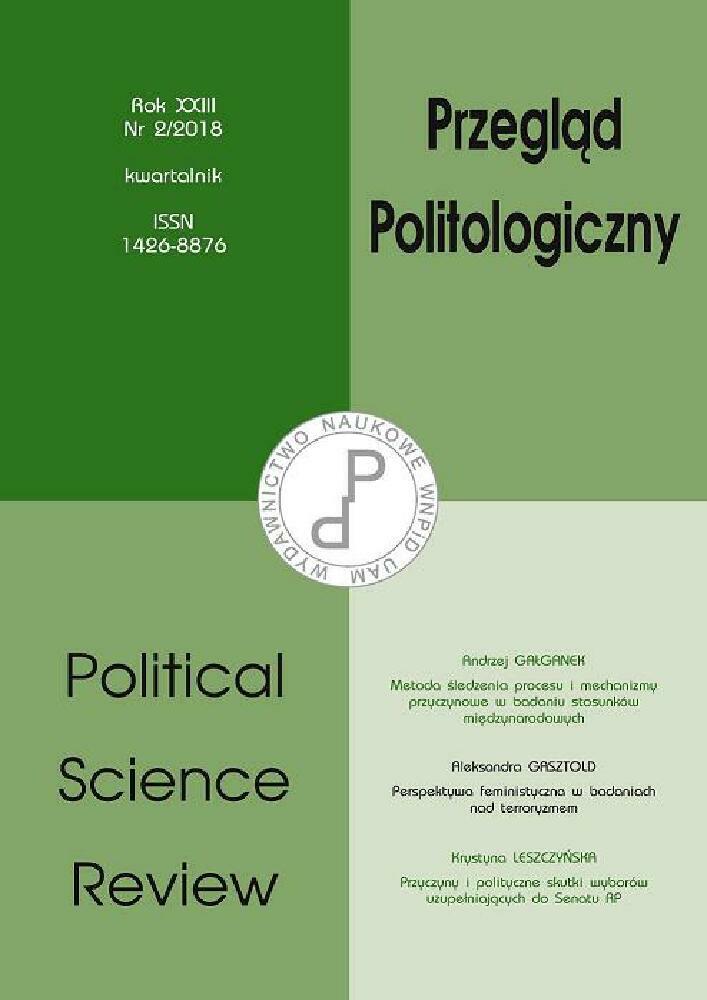Abstract
The aim of this paper is to explore the use of 2×2 games in the study of political phenomena. Basic theoretical issues are discussed and sample applications presented. The theoretical issues include the Nash equilibrium, Pareto optimality and axioms defining the Nash arbitration scheme. Two categories of examples using 2×2 games in political studies are presented: games with symmetrical payoffs and games with non-symmetrical payoffs. In the former category, the relationships between individual payoffs are the same for both players, while in the latter, they are established separately for each participant of the game. The analyses are based on interaction schemes of the Chicken-and-Stag-Hunt type. Game models applied are strategic in form. The payoffs for players are presented graphically (as polygons) in coordinate systems. The analyses conducted present the undisputed advantages of using game-theory models in political science studies. Firstly, game-theory models reduce the phenomena analyzed to their bare essentials and, hence, help researchers focus on the key aspects of each phenomenon. Secondly, the language of mathematics used in game theory is characterized by outstanding accuracy and intersubjective communicability. Finally, the application of game theory tools does not require in-depth knowledge of mathematics.References
Haman J. (2014), Gry wokół nas. Socjolog i teoria gier, Wydawnictwo Naukowe Scholar, Warszawa.
Humphreys M. (2017), Political Games: Mathematical Insights on Fighting, Voting, Lying & Other Affairs of State, W.W. Norton & Company, New York–London.
Komendant-Brodowska A. (2009), Grzech zaniechania. Świadkowie przemocy szkolnej w perspektywie teorii gier, „Decyzje”, nr 11, s. 5–47, http://journal.kozminski.edu.pl/ind ex.php/decyzje/article/view/114/97, 20.07.2017.
Liang X., Xiao Y. (2013), Game theory for network security, „IEEE Communications Surveys & Tutorials”, vol. 15, nr 1, s. 472–486, http://yangxiao.cs.ua.edu/IEEE_COMST_game_2013.pdf, 10.07.2017.
Lissowski G. (2008), Zasady sprawiedliwego podziału dóbr, Wydawnictwo Naukowe Scholar, Warszawa.
Maynard Smith J., Price G. R. (1973), The logic of animal conflict, „Nature”, vol. 246, s. 15–18, ftp://oceane.obs-vlfr.fr/pub/irisson/papers/Maynard%20Smith1973-The%20logic%20of%20animal%20conflict00.pdf, 20.07.2017.
Nash J. F. (1950), The bargaining problem, „Econometrica”, vol. 18, nr 2, s. 155–162, http://www.eecs.harvard.edu/cs286r/courses/spring02/papers/nash50a.pdf, 24.07.2017.
Rapoport A., Chammah A. M. (1969), The game of chicken, w: Game Theory in the Behavioral Sciences, red. I. B. Buchler, H. G. Nutini, University of Pittsburgh Press, Pittsburgh, s. 151–175.
Riechmann T. (2014), Spieltheorie, Verlag Franz Vahlen, München.
Schelling T. C. (1960), The Strategy of Conflict, Harvard University Press, Cambridge, MA, wyd. polskie: Strategia konfliktu, przeł. J. Stawiński, Wolters Kluwer, Warszawa 2013.
Straffin P. D. (2004), Teoria gier, przeł. J. Haman, Wydawnictwo Naukowe Scholar, Warszawa.
Von Neumann J., Morgenstern O. (1944), Theory of Games and Economic Behavior, Princeton University Press, Princeton.
Wilson E. O. (2011), Konsiliencja. Jedność wiedzy, przeł. J. Mikos, Zysk i S-ka, Poznań.

